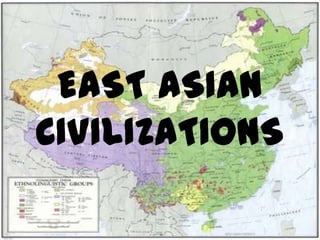East Asian Civilization
•Download as PPSX, PDF•
3 likes•3,187 views
talsk about the early EAST ASIAN CIVILIZATIONS
Report
Share
Report
Share

Recommended
Recommended
More Related Content
What's hot
What's hot (20)
Viewers also liked
Viewers also liked (20)
Similar to East Asian Civilization
Similar to East Asian Civilization (20)
chinesehistory-littandem-130820030540-phpapp02.pdf

chinesehistory-littandem-130820030540-phpapp02.pdf
History and Philosophy of China - The Shaman, I Ching and phliosopherss

History and Philosophy of China - The Shaman, I Ching and phliosopherss
Recently uploaded
Recently uploaded (20)
Basic Civil Engineering first year Notes- Chapter 4 Building.pptx

Basic Civil Engineering first year Notes- Chapter 4 Building.pptx
Presentation by Andreas Schleicher Tackling the School Absenteeism Crisis 30 ...

Presentation by Andreas Schleicher Tackling the School Absenteeism Crisis 30 ...
Role Of Transgenic Animal In Target Validation-1.pptx

Role Of Transgenic Animal In Target Validation-1.pptx
Energy Resources. ( B. Pharmacy, 1st Year, Sem-II) Natural Resources

Energy Resources. ( B. Pharmacy, 1st Year, Sem-II) Natural Resources
General Principles of Intellectual Property: Concepts of Intellectual Proper...

General Principles of Intellectual Property: Concepts of Intellectual Proper...
Russian Escort Service in Delhi 11k Hotel Foreigner Russian Call Girls in Delhi

Russian Escort Service in Delhi 11k Hotel Foreigner Russian Call Girls in Delhi
Unit-IV; Professional Sales Representative (PSR).pptx

Unit-IV; Professional Sales Representative (PSR).pptx
This PowerPoint helps students to consider the concept of infinity.

This PowerPoint helps students to consider the concept of infinity.
Food Chain and Food Web (Ecosystem) EVS, B. Pharmacy 1st Year, Sem-II

Food Chain and Food Web (Ecosystem) EVS, B. Pharmacy 1st Year, Sem-II
Measures of Dispersion and Variability: Range, QD, AD and SD

Measures of Dispersion and Variability: Range, QD, AD and SD
East Asian Civilization
- 2. The earliest Chinese empire is said to be the Hsia Dynasty, but apart from literature, there is no proof of its existence.
- 3. Shang Dynasty •It is the second oldest empire. It is also considered as the first Chinese empire. • According to traditional historiography, ruled in the Yellow River valley in the second millennium BC, succeeding the Xia Dynasty and followed by the Zhou Dynasty. • Archaeological excavations indicate that during the Shang Dynasty, the people used the wheel. They wore silk and furs from animals which were hunted and later, domesticated.
- 4. Shang Dynasty • According to the traditional chronology based upon calculations made approximately 2,000 years ago by Liu Xin, the Shang ruled from 1766 BC to 1122 BC, but according to the chronology based upon the "current text" of Bamboo Annals, they ruled from 1556 BC to 1046 BC. • The emperors of the Shang Dynasty came from aristocratic families who were former military leaders. The war forces of the Shang Dynasty were made up of one thousand (1,000) to ten thousand (10,000) soldiers who rode on chariots.
- 5. Oracle Bones • In 1930, systematic excavation was undertaken in Anyang. The dragon bones were in fact bones of oxen, sheep, turtles, and other animals which were more than three thousand years old. They were called oracle bones. • These bones were consulted by diviners by ancient times in the hope of answering pressing questions like : “When will the rains come?”
- 6. Oracle Bones • Chinese historians and scholars were able to read the writings on the bones, which is similar to modern-day Chinese script. • The vast majority of the inscribed oracle bones date to the last 230 or so years of the Shang dynasty.
- 7. Chou Dynasty • The Chou period lasted for eight hundred sixty six (866) years, from 1122B.C. to 256B.C. • The Chou conquerors explained the reason for their supremacy as “mandate from heaven,” a belief that became the center of Chinese political thought. • According to this belief, Heaven grants the emperor, the “Son of Heaven,” the right to rule as long as he behaves properly and virtuously.
- 8. Chou Dynasty • The Chou first coexisted and then fought with the earlier Shang Dynasty, living to the west of them in what is now Shensi Province, with a capital originally in Hao (Zongzhou). • A good emperor, it was then believed, brought with him peace, good harvest, and contentment among his people.
- 9. Chou Dynasty • In the latter part of the Chou Dynasty, the noblemen built more powerful kingdoms, and initiated wars among themselves. The title “Son of Heaven” became merely symbolic; in reality the emperor was powerless. • By 600B.C. the power of the Chou Dynasty was over, but the legacies remain as enduring traditions of the Chinese people.
- 11. Confucius • He was a Chinese teacher, editor, politician, and philosopher of the Spring and Autumn period of Chinese history. • According to him, harmony in society is attained only if the proper relationship between people is restored and properly observed. • According to him also that virtue is not given or inherited. It is attained through education, and anyone who wants to work for the government must work toward a proper education.
- 12. Confucius • His followers wrote down his teachings in the Five Classics and the Analects. These works became the basis of Chinese education, which emphasizes the fundamental values of benevolence, righteousness, propriety, filial piety, and justice.
- 13. Lao • was a philosopher of ancient China, best known as the author of Tzu Ching (often simply the Tao Te referred to as Laozi). • He blamed society for the individual’s behavior. • According to his philosophy, the laws and traditions created by man forced the individual person to live contrary to the ways of nature, or the “Tao,” causing chaos in society.
- 14. Han Fei • also known as Han Feizi, was a Tzu Chinese philosopher who, along with Li Si, Gongsun Yang, Shen Dao and Shen Buhai, developed the doctrine of Legalism. • According to him, the leading proponent of the school of Legalism, the most important element is the state, and the welfare of the individual person is subordinate to that of state.
